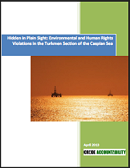A report released by Crude Accountability details how oil spills and demolition of homes in the Caspian Sea region, identified through satellite imagery and analyzed by the Geospatial Technologies and Human Rights Project of the American Association for the Advancement of Science, rob citizens of their environmental and human rights in western Turkmenistan.

Crude Accountability’s new report “Hidden in Plain Sight: Environmental and Human Rights Violations in the Turkmen Section of the Caspian Sea,” describes ongoing oil pollution—captured in satellite images analyzed by AAAS—as a serious threat to the environment of the Turkmen section of the Caspian Sea, and, in particular, to the Khazar Nature Reserve, which is identified by the Ramsar Convention as a protected territory because of its importance to migrating birds. The research shows that since 2000, there have been hundreds of oil discharges into the Turkmen section of the Caspian Sea, including in the areas of ongoing extraction by international companies and close to the Khazar Reserve.
“The images and analysis released by AAAS confirm what Crude Accountability and our partners have long suspected, which is that the extent of environmental pollution from oil and gas exploration in the Caspian Sea has been under-reported,” said Kate Watters, executive director of Crude Accountability. “Our research shows that the nearly continuous oil leak found by AAAS in the Turkmen section of the Caspian Sea is in the area of Block 1 and Block 2, which are operated by Petronas and Dragon Oil, respectively. How such a leak could go undetected and unreported for twelve years is a mystery.”
Turkmenistan is a party to the Aarhus convention, which guarantees that citizens have the right to information about environmental matters, they have the right to participate in decision-making about environmental matters, and they have the right to access to justice when those rights have been violated. In spite of this, the Turkmen government and the companies developing oil and gas in Turkmenistan, including in the offshore blocks in the Caspian Sea, have been exceedingly closed about oil and gas projects. They have failed to be transparent and accountable with regard to the revenues obtained from oil and gas concessions, and they have failed to properly inform and consult with the public with regard to environmental projects.
Satellite images analyzed by AAAS reveal “hundreds of instances in which petroleum discharge has taken place near drilling platforms in the Caspian Sea, and another probable leak adjacent to oil fields on the shores of the Turkmenbashi Gulf,” said Dr. Susan Wolfinbarger, director of the AAAS Geospatial Technologies and Human Rights Project.
The report also describes forced relocation of the villages of Avaza and Tarta, on the Caspian coast of Turkmenistan, to make way for the luxury resort, Avaza, touted by Turkmen President Berdymukhamedov as an ideal destination for international tourists. The village of Avaza was demolished to make way for the resort, and nearby Tarta was also destroyed in 2010. Citizens were not compensated for their losses and it is not clear where they were able to move to.
The full report is available at www.crudeaccountability.org and the AAAS web site.
Crude Press Release
May 6, 2013
Contact: Kate Watters
kate@crudeaccountability.org
571-332-5895
